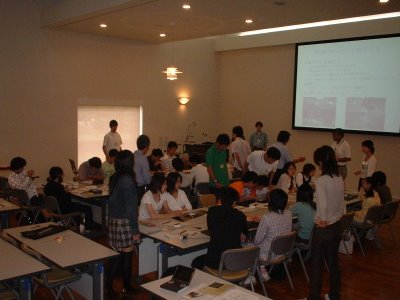Wire Chambers
Belle Plus is off to a good start. Yesterday we had an introductory lecture from Abe san, and then Haba san gave us a tour of the KEKB tunnel and the Belle detector. Afterwards we had dinner and a welcome party, where I was in charge of running a group trivia session, and then we all headed back to the dorm for (non-alcoholic) drinks. All the students seemed really interested, but they are different ages and at different levels so I think we might have a bit of a challenge ahead of us. I spent half the evening explaining how to calculate velocity, distance and time to a first year student, and then spent an hour or two explaining how the weak interaction works and what Feynman diagrams mean to a third year. It’s a bit difficult to entertain everyone at once.
This morning Uno san helped us make wire chambers. A wire chamber is a simple particle detector made out of a tube filled with gas, and a wire with high voltage applied passing through it. When a charged particle (a cosmic ray, for example) passes through the tube, it kicks electrons out of the gas. These are attracted to the nearby wire because the high voltage in the wire creates a strong electric field, and by counting the number of electrons passing through the wire you can calculate the energy of the original cosmic ray.
The students started off with a square pipe and endplates, which had openings for the high voltage supply and the gas input. They paired off to assemble the whole thing. Afterwards we got all the wire chambers together and tested them. They all seemed to be working, but unfortunately we ran out of time. I think Uno san wanted to wire them up in coincidence and count cosmic rays, or measure their angular distribution. It was good fun though. It’s always a good experience when you get to build stuff yourself and check that it works.

This morning Uno san helped us make wire chambers. A wire chamber is a simple particle detector made out of a tube filled with gas, and a wire with high voltage applied passing through it. When a charged particle (a cosmic ray, for example) passes through the tube, it kicks electrons out of the gas. These are attracted to the nearby wire because the high voltage in the wire creates a strong electric field, and by counting the number of electrons passing through the wire you can calculate the energy of the original cosmic ray.
The students started off with a square pipe and endplates, which had openings for the high voltage supply and the gas input. They paired off to assemble the whole thing. Afterwards we got all the wire chambers together and tested them. They all seemed to be working, but unfortunately we ran out of time. I think Uno san wanted to wire them up in coincidence and count cosmic rays, or measure their angular distribution. It was good fun though. It’s always a good experience when you get to build stuff yourself and check that it works.


0 Comments:
Post a Comment
<< Home